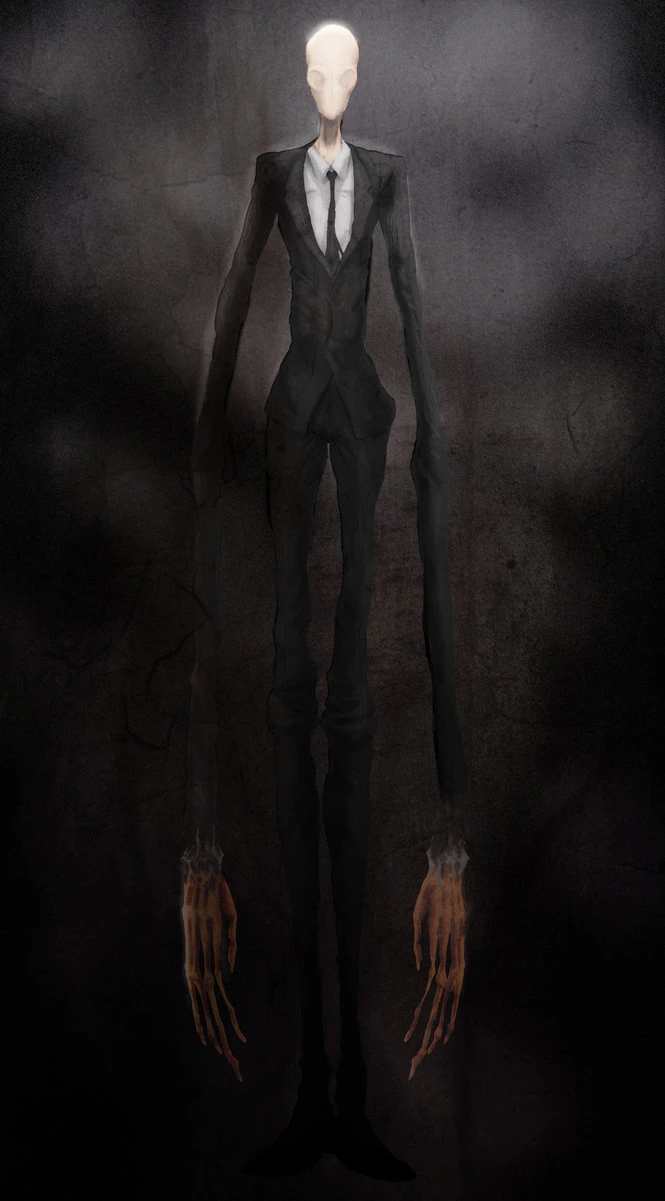 The Slender Man, or Slenderman to his friends, represents one of the most fascinating horror phenomena of modern times and is the direct result of that nebulous entity, that filthy temptress, we know as the Internet. Unlike many urban legends, which have their roots in ancient folklore or unexplained events, Slenderman began virally and unfurled its tentacles to all corners of the earth. This elusive stalker, this haunting presence that pursues its victims relentlessly; what’s not to be afraid of?
The Slender Man, or Slenderman to his friends, represents one of the most fascinating horror phenomena of modern times and is the direct result of that nebulous entity, that filthy temptress, we know as the Internet. Unlike many urban legends, which have their roots in ancient folklore or unexplained events, Slenderman began virally and unfurled its tentacles to all corners of the earth. This elusive stalker, this haunting presence that pursues its victims relentlessly; what’s not to be afraid of?
The Slender Man is an entity who predominantly targets children or young adults that have suffered some major trauma. It follows them, takes delight in psychologically tormenting them, and then eventually abducts them. Remove that last part and he sounds like every ex-boyfriend I’ve ever had. He is said to haunt forests or abandoned locations, has the ability to teleport, and may stalk his prey for months or even years. He may look like an upper class businessman, but he has all the sleazy determination of a used car salesman.
Close or extended proximity to Slenderman will trigger a condition known as “Slender sickness”, where victims will experience rapid onset paranoia, nightmares, delusions, and nosebleeds. So basically just your typical night in an underground rave, but with a creepy monster stalking you. Scratch that, just your typical night in an underground rave.
In the web series Marble Hornets, it was established that Slenderman could create “Proxies”, which are human beings who have fallen under his influence and act as his puppets. Kind of like Beliebers, only a lot less violent. They also introduced the “Slenderman Symbol”, a circle with a cross through it that looks about as macabre as a children’s drawing, and the concept that his presence interfered somehow with video and audio recordings.
 With all that in mind, Slenderman is unique in that his stories rarely employ graphic violence or body horror. Originally it was believed that he impaled his victims on tree branches, removed all of their organs, placed them in plastic bags, and then returned them to the victim’s body. Kind of like a piñata for people on the organ donor list. As the Slenderman canon developed, he became far more of a passive aggressive creature, choosing instead to stalk his victims and kill them in unknown ways. In fact, since no bodies are ever recovered, it is unknown whether he even kills his victims or simply spirits them away to an unidentified place. This leaves both his motives and modus operandi incredibly vague.
With all that in mind, Slenderman is unique in that his stories rarely employ graphic violence or body horror. Originally it was believed that he impaled his victims on tree branches, removed all of their organs, placed them in plastic bags, and then returned them to the victim’s body. Kind of like a piñata for people on the organ donor list. As the Slenderman canon developed, he became far more of a passive aggressive creature, choosing instead to stalk his victims and kill them in unknown ways. In fact, since no bodies are ever recovered, it is unknown whether he even kills his victims or simply spirits them away to an unidentified place. This leaves both his motives and modus operandi incredibly vague.
Yet on May 31st 2014, the Slenderman stories became far too real for the residents of Waukesha, Wisconsin when a couple of 12-year-old girls lured one of their classmates into the woods, held her down, and stabbed her 19 times. Fortunately the victim was able to crawl out of the woods and onto the roadside, where she was found by a passing cyclist and promptly rushed to hospital. She survived and the perpetrators were swiftly apprehended. When questioned by the authorities, the two girls claimed that they had read about the Slender Man online and had attempted to murder the other girl in the hopes of becoming his Proxies.
During an interview, one of the girls believed that Slenderman watched over her, could read her mind, and could teleport. That being said, she also believed that she’d had extended conversations with Lord Voldemort and one of the Teenage Mutant Ninja Turtles, so perhaps not the most reliable source. The girls are being tried as adults and are now facing up to 65 years in prison.

Not long after this news story broke, an unidentified woman from Hamilton Ohio informed a WLWT TV reporter that her 13-year-old daughter had attacked her with a knife and written macabre fiction usually centred on Slenderman. Then, on September 4th 2014, a 14-year-old girl in Port Richey, Florida set her home on fire while her mother and nine-year-old brother were still inside. A police report later confirmed that the teenager had been reading online stories about Slenderman, as well as the manga Soul Eater by Atsushi Ōkubo.
So why, in spite of his clearly fictional status, has the Slender Man become so popular? And what is it about him that makes him both horrifying and strangely alluring?
Appearance
 Slenderman is the master of chic, as he is regularly depicted wearing a black suit, white shirt, tie, and long, black dress shoes. However, since he is entirely based on random accounts by various authors, his appearance is not fixed and continues to change. Typically he is depicted as a thin, unnaturally tall man with a blank and featureless face. In some cases he has no face, while in others he has a different face depending on who is looking at him.
Slenderman is the master of chic, as he is regularly depicted wearing a black suit, white shirt, tie, and long, black dress shoes. However, since he is entirely based on random accounts by various authors, his appearance is not fixed and continues to change. Typically he is depicted as a thin, unnaturally tall man with a blank and featureless face. In some cases he has no face, while in others he has a different face depending on who is looking at him.
Some people portray him as having many tentacles that protrude from his back, although it is noted he can retract them at any time. It is believed that, once his arms and tentacles are outstretched, his victims are lulled into a kind of hypnotised state, where they helplessly walk towards him and become ensnared in his trap. Hypnotic tentacles, you say? We’re looking at you, Japan.
Origins
The Slender Man’s origins are part of what makes him so fascinating, as he started as an Internet meme created by Eric Knudsen, known online as Victor Surge, on the Something Awful forums. Two black and white photographs containing Slenderman were posted to the forum on June 10th 2009 as part of a photoshop contest where users were challenged to create “paranormal photographs”. Knudsen supplemented his submission with a few snatches of texts from “witnesses”, which further fleshed out the original story. One such statement reads: “We didn’t want to go, we didn’t want to kill them, but its persistent silence and outstretched arms horrified and comforted us at the same time…” — 1983, photographer unknown, presumed dead.

Slenderman rapidly and unexpectedly went viral, spawning numerous works of fanart and fanfiction, particularly on the website Creepypasta. Our slender pal swiftly became divorced from his original creator and subject to an overarching mythos created by a range of authors. In her book Folklore, Horror Stories, and the Slender Man: The Development of an Internet Mythology, Professor Shira Chess attempts to compare Slenderman to ancient folklore about fairies. Because fairies are vague looking creatures that haunt woods and kidnap children too! Except they don’t have tentacles and an Armani suit.
Chess argues that, although Slenderman’s origins can be identified and he is clearly fictional, he can still be classified as folklore because he was created by a collective whose stories change depending on the storyteller. According to Chess, the way the Slenderman mythos has developed online provides a fascinating insight into how traditional folklore becomes established. Some people attribute Slenderman’s success to the ambiguous nature of the Internet, which consistently blurs the line between fact and fiction by providing the reader with myriad stories that breathe authenticity into the lie. Yet why do we want to believe in this faceless fashionista so badly?
 Chess believes that he represents the looming threat of death and the helplessness involved when faced with anonymous, unknown forces. Others posit that he simply represents fear of the unknown, which is a fear that is growing ever stronger in the modern age of technology and information. The creator of Marble Hornets, Troy Wagner, posits that Slenderman is terrifying because of his malleability, as he can shape himself into whatever the reader is most frightened of. Other theories suggest that he guards the undefined cultural boundaries that are alarming simply because victims do not know when they have violated them.
Chess believes that he represents the looming threat of death and the helplessness involved when faced with anonymous, unknown forces. Others posit that he simply represents fear of the unknown, which is a fear that is growing ever stronger in the modern age of technology and information. The creator of Marble Hornets, Troy Wagner, posits that Slenderman is terrifying because of his malleability, as he can shape himself into whatever the reader is most frightened of. Other theories suggest that he guards the undefined cultural boundaries that are alarming simply because victims do not know when they have violated them.
Perhaps, as a modern-day Pied Piper figure, he could even be seen to represent the faceless populace behind the computer screen. Slenderman is that vague, humanoid threat that you consistently meet on the web, that unknown force which can reach out and ensnare your children. Because, after all, how do you know who you’re really talking to when you never see their face?
Modern-Day Usage
As this post is getting a little long, let’s not be coy about this. Here are but a few of the modern-day references to our skinny friend:
- The Youtube video series Marble Hornets is a found footage style fictional documentary about a group of high school students and their encounters with Slenderman. It has received over 55 million views.
- Other, similar Youtube serials include EverymanHYBRID and TribeTwelve.

- In 2012, a video game entitled Slender: The Eight Pages was released based on a fictional encounter with Slenderman. The video game was so successful that it was swiftly followed by a sequel, known as Slender: The Arrival, and it inspired similar games such as Slenderman’s Shadow and Slender Rising.
- The independent film The Slender Man, released in 2013, was funded by a Kickstarter campaign and is based on Slenderman.
- Slenderman makes a cameo appearance in the music video for the song “Equinox” by Skrillex.
- The character Enderman in the indie video game Minecraft is believed to be based on Slenderman.
- He bears great similarity to a “modern Yōkai” or urban legend created on Japanese websites known as the Kunekune, which appeared online around about 2003.
- He’s also visually very similar to SCP-096 or “Shy Guy” from the SCP series.
- The Slendy Review is a blog dedicated entirely to stories in the Slenderman canon.
Want to support us so that we can continue creating great horror content? Then sign up to our Patreon.
